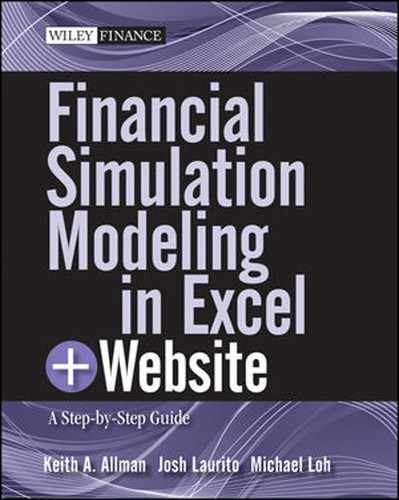CHAPTER 6
Simulating Pools of Assets
Observing relationships among asset prices and then using these relationships to forecast future prices is at the heart of simulation modeling. Generally, investors hope to do in-depth research and analysis on each investment they make and on the risks associated with the idiosyncrasies of each asset. However, as portfolios grow, such analysis is often impractical or even impossible. Certain asset-backed securities, for example, are made up of tens of thousands of loans, each one in an amount of less than $10,000.
In situations involving too many assets for individual analysis, the typical methods of analysis are to implement a simulation of either price movement or of defaults. Typically, “Monte Carlo” simulations are used for this type of analysis. Although we covered Monte Carlo–style simulations previously in this text, they will be at the center of this chapter, and so a quick background on this important method may be helpful.
Monte Carlo simulations were first developed during World War II as part of the Manhattan Project. They take their name from a famous casino located in Monaco. They were named as such not because they were developed for gambling, but because they reminded their creators of the draws in card games, and so a gaming name was chosen to convey their probabilistic nature.
To this day we use similar terminology. These simulations involve repeated random “draws” from a defined set of possible values, so-called because you can think of the number being selected as being analogous to drawing from a deck of playing cards. As with playing cards, you can calculate your probability of selecting a number, but you do not know what card or value you are going to get until it is actually pulled out (or in the case of simulations, generated). This set of characteristics represents both the greatest strength and greatest weakness for these simulations.
The strength of these simulations is that they allow us to calculate the impact of thousands or even millions of combinations of price movements or defaults. Since we cannot know the price movements of the market before they happen, Monte Carlo simulations allow us to obtain reasonable projections of how likely different price movements are and to estimate portfolio characteristics accordingly. An analyst can design a portfolio based on the anticipated correlation in price movement between different assets to minimize downside risk, just like the way a card player can decide whether to draw a card or not based on the odds of winning a hand.
The major weakness of these simulations is that the probability of price movements in the future cannot be known with certainty. A card player can calculate with certainty the probability of drawing the nine of diamonds from a full deck, and this probability will be true at all times, assuming that the deck is full. However, we cannot calculate with certainty the probability that any asset will experience a nine-percent drop in value in a day; we can only estimate that probability based on historical price movements. Furthermore, the probability of a drop in asset value is likely to change over time; there is no guarantee that the future will look like the past, or that prices will behave in the future the way they have in the past. We cover more about the weaknesses of simulation modeling and the “Ludic fallacy” in Chapter 8.
While we need to be aware of these deficiencies, the value of simulating pools of assets can be a valuable tool in the process of portfolio design and risk assessment, as well as being required under certain regulatory regimes. Correlation, which we covered in Chapter 3, is a key variable in simulating pools of assets, but it is not the only variable that we will need to consider.
